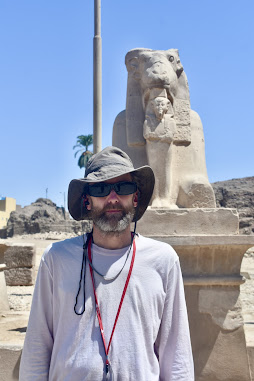Day 4 Aug 31 Pt 1 Flight to Luxor, the HS Antares and Karnak
We had to get up early to get to the airport in order to fly to Luxor. They told us to be ready to board the bus at 6 AM, so we were up and on board before the sun rose.
It was pretty hard to get any good photos out the bus window with so little light, but that didn't stop me from taking a few anyway!
When we arrived at the airport, the luggage guys were waiting for us.
They unloaded us and we headed to the security checkpoints (of which there were two) before we checked our bags. One of our group was in a wheel chair. She was a real trooper, who did not have it easy on this trip. I really admire her grit for taking this trip.
We boarded a charter flight for Luxor and I got my first view of the rest of the Egyptian countryside. It is so different from the green strips that border the Nile. The desert is vast and inhospitable, but somehow the Egyptians manage to inhabit it.
Especially interesting are the dried beds of places the river flowed when there were floods.
Beautiful tree-like patterns fan out in the desert as if they were rivers that retained water.
Of course we napped a bit on the plane, but not enough. Still it fortified us for the rest of the day. We landed in Luxor to a welcome sign in hieroglyphics transliterated from English. I thought that was such a sweet undertaking.
Then it was back into a bus and more driving along the Nile and its canals.
Luxor used to be called Thebes back in ancient times and is mentioned by Herodotus in his Histories. How exciting it was to see the first signs of the Avenue of the Sphinxes!
The Avenue of the Sphinxes (طريق الكباش) was a 1.7 mile road that connected the Temple at Karnak to the Temple of Luxor. It was lined with over 600 hundred (originally 1057) sphinxes. Famed archaeologist Zawi Hawass has called this site , "the largest open [air] museum, the largest archeological site in the world that tells the history of Egypt from the 2,000 BC era known as the Dynasty XI — until the Roman Period."
As you enter the Temple at Karnak you encounter a large model of what the temple must have looked like in its heyday.
Because the Avenue of the Sphinxes connects the two main temples in Luxor, I thought I would check out Google Earth and see what it looks like from above (and it is pretty cool!) You can see the whole avenue with the temple of Karnak in the North and of Luxor in the South.
Here is just the Temple of Karnak
The Cornell University Library has these amazing 1914 overhead shots of the temple grounds that I am putting in just to give you an idea of how all the pieces fit together.
You would need to rotate the photo 90 degrees counter/anti-clockwise to have the same orientation. In these photos it looks like both the Obelisks erected by Queen Hatshepsut are still standing.
The Temple at Karnak is reputedly the largest religious building ever constructed and it is probably the most impressive thing we saw on our tour.
I was fascinated by the sphinxes which took on three basic forms: sphinxes with the head of a ram and body of a lion, sphinxes in regular ram shape and sphinxes with human heads and lion bodies.
The Avenue underwent decades of restoration and was finally opened up in 2021.
Work continued on through the ptolemaic period thousands of years later (305-30 BC).
Our guide maintained that the statue below was not authentic because of the placement of the Nefertari figure in front of Ramses the Great.
It is the enormous pillars that are most impressive about Karnak.
Here is our group navigating the hypostyle.
Ramses II has his name plastered over almost every area of the temple. Here you see the ankh nsw bty prefix (Life force ruler of the two kingdoms) before his famous cartouche. In some places the color remains very clear
There are numerous reliefs of Ramses II paying homage to the River gods, and other gods throughout the temple complex.
To set up the enormous obelisks they had to use a complex process of sand and cantilever action.
It is amazing to realize that the temple consists of four parts and only this one piece is open to the public. The other three are the precinct of Mut, the precinct of Montu and the Temple of Amenhotep IV (also known as Akhenaten) are all closed to the public. (The precinct of Mut may be open now after Brown University's restoration). Unfortunately the Temple of Amenhotep was razed after his death by the priests he had (temporarily) displaced by proclaiming monotheism.
The obelisk was constructed by Hatshepsut, who also worked on reconstructing the Precinct of Mut which had been destroyed by the invading Hyksos.
There is much speculation about how those architraves (big lintels on top of the columns) got up there. Some say ramps of sand, some say levers.
The Hypostyle was possibly started in the 18th dynasty, but grew to its present splendor in the 19th Dynasty under Seti I and Ramses II.
Here you can see the Papyrus umbels capitals so famous to this temple.
I don't think I could ever have enough time at this temple, so all too soon it was time to head back to the bus. Once again we passed along the Avenue of Sphinxes...
...bidding them farewell.
Then it was off through the streets of Luxor to the Luxor Library and museum.
We picked up the avenue again as we approached the Luxor Heritage Center.
The Heritage Center rested at the foot of the Avenue of the Sphinxes.
After seeing a video about the Nile, we headed to the place where our new home for a week was docked. The crew had a lovely welcome prepared for us with cool towels and drinks and smiling faces.
And there she was... the HS Antares.
We boarded over a red carpet and felt immediately at home.
Our room was wonderful. It was large, elegant and not at all what one expects from a cruise.
I love the retro style and calming colors.
I frequently used that chair to write in my journal or simply sit with the veranda door open and watch the Nile go by.
(Taking a few pictures here and there of course).
The rest of the ship was equally clean and stylish.
I had expected threadbare and worn since it was an "old" ship, but there was no sign of deterioration and no dirt. It was beautiful, spacious and just exactly what I had hoped for.
Here are the cooks and wait staff hard at work during our first meal. Below is the waiting room outside the restaurant.
There were numerous public areas that were comfortable and alluring.
Of course there was always a useful meeting each day to keep us abreast of what would be happening. Here we were welcomed onto the ship by our hotel manager.
Another daily ritual was hearing about dinner from our gifted Romanian chef.
One mandatory aspect of a cruise is the emergency drill. In that ritual everyone gets dressed up in their finest orange and heads to a social gathering.
I guess orange really is the new black.
When the party was over we headed for our rooms. We still had another outing that evening: the Temple of Luxor at 5:30 PM.














.jpg)























































No comments:
Post a Comment